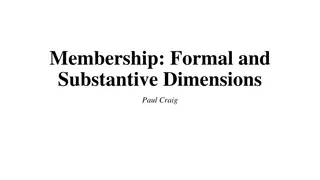Challenges and Solutions for the European Union's Borders
The European Union faces issues with its borders, specifically regarding migration and the reintroduction of internal borders. The Schengen Area plays a crucial role in facilitating movement between member states. EU regulations allow temporary border checks in certain circumstances. The arrival of migrants may not always constitute a threat to public order or security, as per the European Court of Justice.
Download Presentation

Please find below an Image/Link to download the presentation.
The content on the website is provided AS IS for your information and personal use only. It may not be sold, licensed, or shared on other websites without obtaining consent from the author.If you encounter any issues during the download, it is possible that the publisher has removed the file from their server.
You are allowed to download the files provided on this website for personal or commercial use, subject to the condition that they are used lawfully. All files are the property of their respective owners.
The content on the website is provided AS IS for your information and personal use only. It may not be sold, licensed, or shared on other websites without obtaining consent from the author.
E N D
Presentation Transcript
THE EUROPEAN UNION FACING THE CHALLENGE OF ITS BORDERS
2 INTRODUCTION
Migration and Refugee Crisis Mediterranean routes 3
4 The reintroduction of the borders in the European Union, is it the solution to the migration crisis ?
I. The reintroduction of internal borders : The response of European member States to migration crisis 5 A) The Schengen area deeply weakened B) The consequences of a weakened Schengen area II. The European alternative to the migration crisis : The search for a convergence of states interests A) The inefficiency of the common migration policy B) The preservation of the Schengen area
6 I. The reintroduction of internal borders : The response of European member states to migration crisis A) The Schengen area deeply weakened
The Schengen Area 7 The Schengen area is a common space in which people are unrestricted to move from one member country to another. The Schengen Agreement was signed by 26 states (22 of 28 EU members of the EU, and 4 associated non-EU states) in June 14, 1985. It has been entered into force since March 26, 1995.
EU Regulation 8 Articles 25 and next ones of the Schengen Borders Code state that : However, the member states of the Schengen area have the possibility of restoring temporarily checks at their national borders, in case of threats to public policy or internal security, for renewable periods of 30 days up to 6 months . Since 2013, this period has been extended to two years in case of a serious breach of control obligations by a member state of the European Union at the external borders .
9 Does the arrival of a large number of migrants constitute a real threat to public order or internal security ? According to the European Court of Justice, it seems not : Derogating from the fundamental principle of the free movement of persons must be interpreted as a restrictive way The danger to public order presupposes the existence of a real, current and sufficiently serious threat, affecting a fundamental interest of society
Several proposals 10 The European Commission The Netherlands Coordinated approach of temporary border controls Minimal Schengen Area Not including Greece from the Schengen Area
11 B) The consequences of a weakened Schengen area
The potential consequences 12 2 3 4 1 A judicial and policial cooperation compromised between the Member States of the EU Economic prosperity in danger The end of a frontierless area ? Economic, Political and Social Costs for the European Union and each of its member states According to a study, member states of the EU will have to pay about 470 billion euros in ten years
Possible issues : 13 Member states have to learn how to work together The European Union should be able to pursue a common migration policy
II. The European alternative to the migration crisis : The search for a convergence of states interests 14 A) The inefficiency of the common migration policy
The Solidarity Principle / The Dublin Regulation 15 European agenda on migration Dublin Regulation The asylum seeker has to register in the member state where he originally entered Relocation plan This plan distributes the asylum seekers from Greece and Italy all around the EU November 2017
The failure of the solidarity system 16 A different reception policy in every member state Two factors The refusal of application by certain East EU countries
The failure of the solidarity system 17 November 2017
The EU decided to intervene in two different ways : 18 1 2 With the conclusion of agreements with certain third countries With a strict position towards these
A strict position towards certain East EU countries 19 CJEU on September 6, 2017 : Reaffirm the solidarity principle between Europeans regarding the immigration management. Vote Law Soros on June 20, 2018 : Makes illegal for individuals or organizations to support the asylum seekers. Symbolic Political On July 2018 : The European Commission engaged a procedure under the article 7 of the Treaty of the EU On September 12, 2018 : The European Parliament voted in favor of the article 7 of the Treaty of the EU
The EU - Turkey refugee agreement 20 3 2 1 A visa liberalization for Turkish citizens who want to travel to the Schengen Area To open the Turkey s road to EU membership An allocation of 6 billion euros to help Turkey care millions of refugees hosted in the country
Angela MERKEL : The German chancellor 21 Future Africa will be structured like the agreement between the EU and Turkey agreements with North
RECEP TAYYIP ERDOGAN : The president of the Republic of Turkey 22
Jean Claude JUNCKER : The president of the European Commission 23 We clearly need immigration in the the coming decades. If we don t opening legal pathways for migrants towards Europe and inside Europe, we will be lost . On European Commission took this idea over and quoted pathway is a key element for border s management September 12, 2018 : The that the legal
24 B) The preservation of the Schengen Area
The closure of the Balkans route 25 At the beginning of March 2016, the migration route of the Balkans gradually closed. Indeed, Macedonia, Serbia, Croatia and Slovenia, but also Austria closed their borders. Moreover the Balkans and Central Europe countries didn t come back on their unilateral decisions to close the borders. Their goal was to discourage new migrants to come in Europe, but the measure did undoubtedly aggravate the humanitarian crisis in Greece as well as increased pressure on the European Union and Turkey to finalize their agreement to manage the flow of refugees.
Map of hotspots in Greece and Italy as of February 2018 26 Hotspots are facilities set up at the EU s external border (in Greece and Italy) for the initial reception, identification and registration of asylum seekers and other migrants coming to the EU by sea. They also serve to channel newly-arrived people into international protection, return or other procedures. There are currently five hotspots in Greece (on the islands of Chios, Kos, Leros, Lesvos and Samos) and five in Italy (in Lampedusa, Messina, Pozzallo, Taranto and Trapani).
About asylum applications. 27 Countries of destination: Germany, Italy and France the main With 198 thousand applicants registered in 2017, Germany accounted for 31 % of all first- time applicants in the EU-28. It was followed by Italy (127 thousand, or 20 %), France (91 thousand, or 14 %), Greece (57 thousand, or 9 %), the United Kingdom (33 thousand, or 5 %) and Spain (30 thousand, or 5%).























